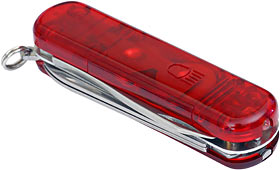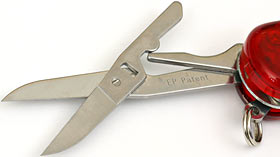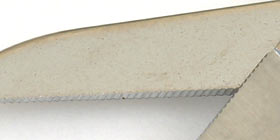
Swiss Army Micro-Light Pocket Tool Chest
Review date: 12 October 2003.Last modified 03-Dec-2011.
I can't figure it out.
Humans are tool-using animals, right?
And yet every day, I meet humans who carry no tools.
No, a mobile phone does not count as a tool for these purposes, unless it's an old analogue Motorola. They work pretty well as a hammer.
Don't get me wrong, here. I don't expect everyone to dorkulate around town wearing a utility belt full of gizmoes. But c'mon, people. One little pocket knife. They're useful. Humour me.
I'm pretty much preaching to the choir on this site, of course. Many of my readers march in yearly Nerd Pride parades, and have problems with putting multi-bladed spring-loaded plier-knives through the wash the same way normal people have problems with tissues.
But your big chunky Gerber and Kershaw and, of course, Leatherman multi-tools are not fully compatible with casual everyday life. Many multi-tool companies produce smaller tools, often but not always based on scissors, but even the little models are too heavy, too pointy or just, well, too butch for many people.
It is not a sin to want a pocketknife that can occupy a jeans pocket without poking holes in it or rubbing the skin off your thigh, or a tool you can attach to your key-ring without making it feel as if it unlocks a service station toilet.
Hence, the continuing popularity of friendly little round-ended Swiss Army knives, even among those of us who own more big plier-based multi-tools than pairs of shoes. Or than individual shoes, in many cases.
This funkily translucent-sided item is the Swiss Army Micro-Light Pocket Tool Chest, and it's a good candidate for what people who use the word "tactical" to describe too many things like to call EDC, or Every Day Carry.
Closed, it's less than 65mm (2.6 inches) long, not counting its little keyring/lanyard loop, and it weighs about 37 grams (1.3 ounces).
The only really unusual thing about the, um, MLPTC, is...
...that Micro-Light part.
The various Photon Micro-Lights are, arguably, the best tiny key-ring LED flashlights out there (I've reviewed some of them here), and Photon teamed up with Wenger (or their marketing people did, anyway) to make this knife.
Squeeze the little embossed light symbol on the side, and a white 3mm mini-LED on the end of the knife lights up.
The light isn't terribly bright by single-LED-flashlight standards, but it's quite bright enough for seeing where you're going at night, finding keyholes, poking around behind desks, and the other random things for which you're likely to need it. It has an unusually wide beam, too; more than 90°. This makes it close to useless for anything beyond indoor distances, but the trade-off is that it's surprisingly good at lighting a whole room, albeit dimly.
The light's squeeze switch is momentary-only, like the one on the original Photon I. There's no way to latch it on without clamping something onto the knife. For most people's purposes, though, a momentary switch is fine - and it also means the light isn't likely to stick on in your pocket and run its little batteries flat.
Apart from the light, the Micro-Light Pocket Tool Chest is the same as the standard, light-less, Pocket Tool Chest. It gives you a blade with about 4cm of edge, a nail file, a key ring attachment, slide-out tweezers (better than nothing, but certainly not Miracle Points), a fine slotted screwdriver with a 1.5mm tip (small enough for many eyeglass screws), a combo bottle opener and chunkier screwdriver (with a tapered two-point-something millimetre tip that'll engage many cross-head screws reasonably well), and a reamer/awl with a "sewing eye" in it, which you shouldn't expect to use for sewing anything much more delicate than a canvas sail.
The bottle opener/screwdriver has a notch in it that's meant to be a "wire crimper"; good luck with that. Similarly, the reamer/awl has a crescent cut out of it that's meant to be a cuticle pusher. OK, whatever.
The MLPTC also, of course, has a little pair of scissors. They're quite nice.
Users of Victorinox Swiss Army knives don't get scissors this good. The Victorinox scissors have a little spring to re-open the blades after they cut; the spring works passably well, but can pop out from under the moving blade.
This is a Wenger Swiss Army knife, though, so it gets a lift-arm sort of scissor-opener, cunningly sprung from the inside. There's also a slot cut out of the moving blade that mates with a nub on the stationary one and stops the blade from flipping right around to poke your index finger.
The Wenger scissors have a "self sharpening" serrated edge, which may or may not be greatly more durable than the standard edge (I pity anyone who has to use Swiss Army scissors frequently enough that they find out), but which should cut heavier materials a little better, at the cost of requiring more effort to do it.
At this point, you may be wondering what this Wenger/Victorinox deal is.
All "Swiss Army" knives are not the same. The best ones, quality-wise, are made by Victorinox, who are the original Swiss Army manufacturer. It's easy to tell; Victorinox knives have the company name stamped on the base of their biggest blade.
If the biggest blade says "Wenger", then you're looking at a knife that's made by the second company to license the "Swiss Army" brand. Wenger make various other stuff as well.
A Wenger knife will probably be of mildly lower quality than a Victorinox one - which is to say, it'll still be very good - but if it's got scissors, they'll be a bit better.
Both of these flavours of Swiss Army knife are "genuine", and made in Switzerland. There are lots of cheap knockoffs that aren't. They're generally quite awful.
Getting back to the product in hand - like all standard-design Swiss Army knives, the MLPTC has no locking blades. Everything can be closed about as easily as it opens. You should always bear this in mind when using the tool, especially when you're using the knife blade; if you bear down on it the wrong way, it'll close on your hand.
The MLPTC's tweezers don't have the usual Swiss Army grey plastic base; they've just got a little bent hook-thing. The reason for this becomes apparent when you read the instructions.
The hook is for pulling out the battery drawer.
These two lithium coin cells are CR1216s - 12mm in diameter, 1.6mm thick. The rated capacity of even premium CR1216s is only about 30 milliamp-hours (mAh), when delivering microscopic current, which they aren't when they're powering an LED. Even without taking current-induced capacity sag into account, though, one alkaline D cell contains something in the order of 140 times as much energy as a pair of CR1216s.
For this reason, I'm glad that the MLPTC LED isn't tremendously bright. That means it won't beat the tiny cells to death too quickly.
As with all coin-cell-powered LED lights, this one's LED will spend most of its on-time glowing at rather a lot less than its initial brightness. The high drain put on the cells means the light brightness sags considerably from its initial power over even the first few minutes of use.
Fortunately, LEDs produce light of the same colour no matter how weakly they're driven, down to the point where they wink out entirely. So even near-dead batteries will be better than useless in an MLPTC. Many people use these sorts of lights for years on end without changing the batteries.
Buying one
My review MLPTC came direct from Photon - actually, their company name is Laughing Rabbit Incorporated, but never mind. If you follow that link and buy stuff, I'll get a cut.
LRI sell the MLPTC for $US44.95, but it's on sale for $US39.95 as I write this. They also stock the simpler Micro-Light Esquire knife, which is currently on sale for $US29.95.
To make sure I wasn't telling my readers to go and get ripped off in order to line my pockets, I poked around the Web for better prices than these.
You can get the regular Pocket Tool Chest, sans light, for less than $US25 if you shop around. The MLPTC is a bit harder to find. The dodgier dealers have it for under $US30, but are likely to soak you on shipping and "handling".
Photon, in contrast, include First Class Mail shipping within the USA in their price, and their overseas shipping fees are reasonable, too. Air mail to Australia for a MLPTC is only $US5.30.
Most "cheap" dealers in the US charge more than that for ground shipping to a customer five miles away.
So, if you buy from my link, you're likely to be paying a buck or two US more than you otherwise would, at worst.
If you're really strapped for cash and want an MLPTC, check out eBay; lots of pocket-tools get sold there, often at monstrous discounts. I've bought pocketknives that way; you usually get a beat-up box with a brand new knife in it, and that's good enough for me.
If you want to just buy the thing without any fuss, though, click here.
Overall
Many people think of Swiss Army knives as all being relatively humungous, whether traditional oval or new-style contoured. The MLPTC manages to pack in a lot of utility without being significantly bigger than my little finger, though, and that's a big point in its favour.
Some other companies have specialised in multi-tools ranging from the merely small to the practically undetectable, and some such things are downright cute, but the real tinies seldom have more than a few real functions.
My own everyday pocket-knife is a Victorinox Minichamp. It's even smaller than the MLPTC, but is full of useful things - even the cuticle pusher, which you can use as a slotted screwdriver. OK, the orange peeler isn't really useful for much beyond puzzling people who don't know what it is, and the second blade is possibly overkill (the idea is that you save it for emergencies, so you've always got a really sharp blade in case you suddenly find yourself sawing through your seatbelt in an underwater automobile). But by and large, the Minichamp's a wee ripper.
I don't need a light on my pocketknife, because I also have an Arc-AAA in my pocket. I don't really need the pen on the Minichamp, either, because I also always carry a Fisher Bullet Space Pen, but the current Minichamp doesn't give you a choice. The original model had the standard toothpick-and-tweezers instead.
(The Minichamp also comes in a LED-light variant, by the way, with a red LED.)
If I did need a light on my pocketknife, I'd seriously consider the Micro-Light Pocket Tool Chest for, ahem, EDC. It's small, it's light, it's useful, it's well made, its LED light is quite good, and it's not stupidly expensive either.
Recommended.
Review Swiss Army Micro-Light Pocket Tool Chest kindly provided by Laughing Rabbit Incorporated.








